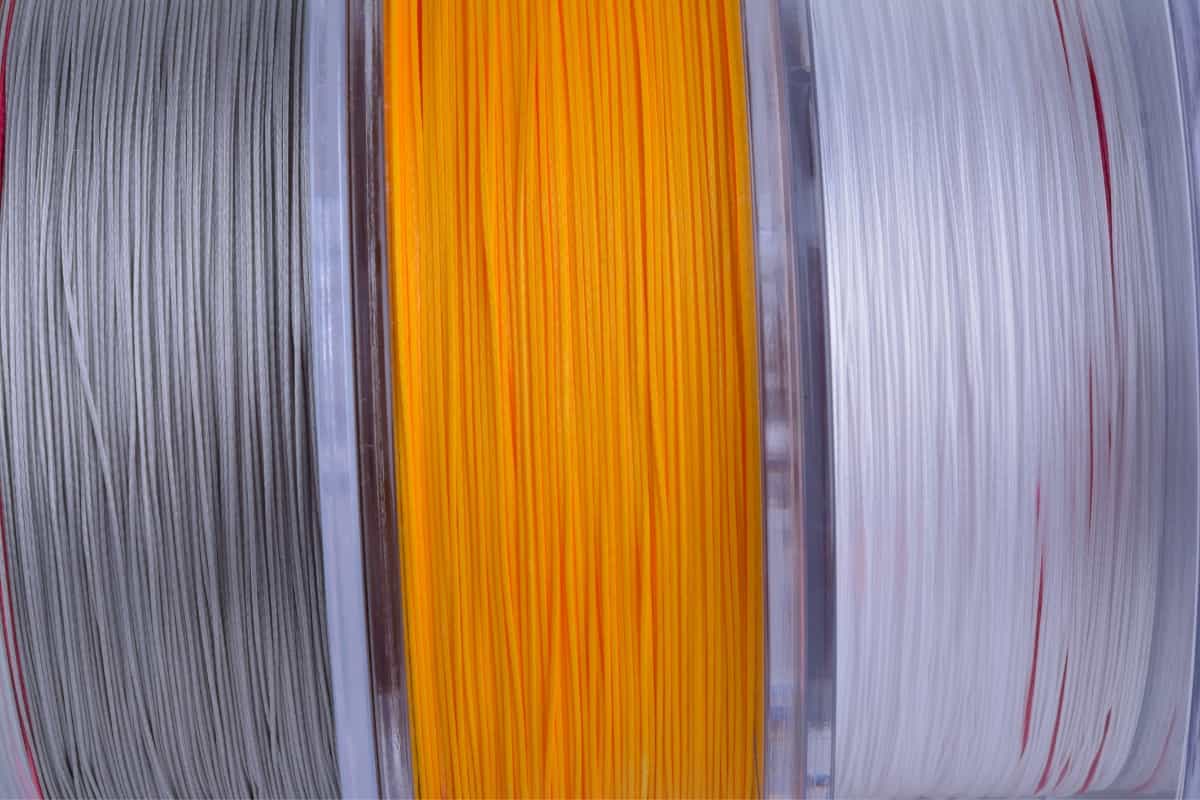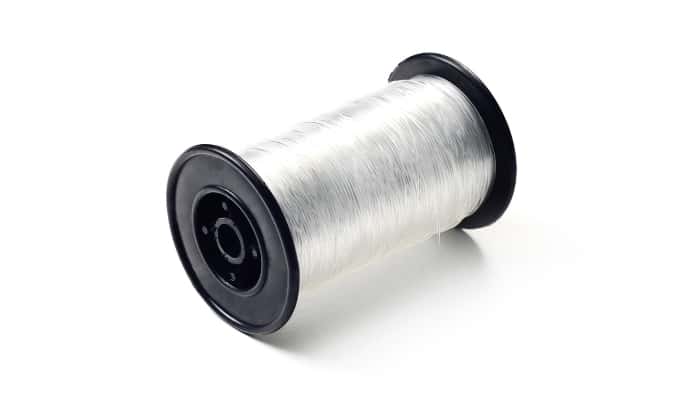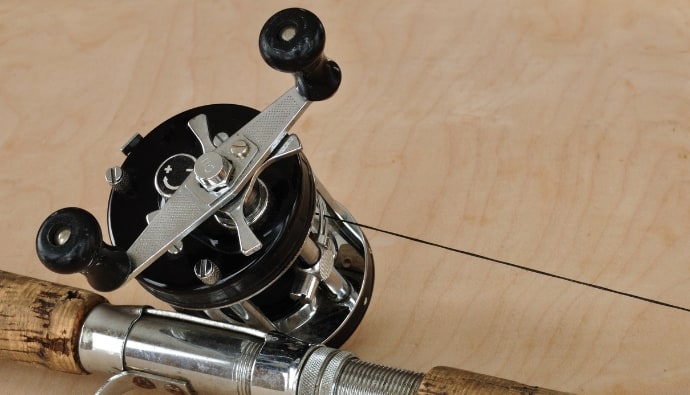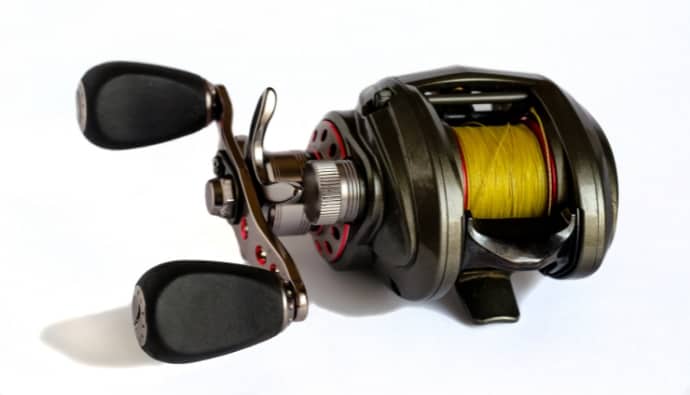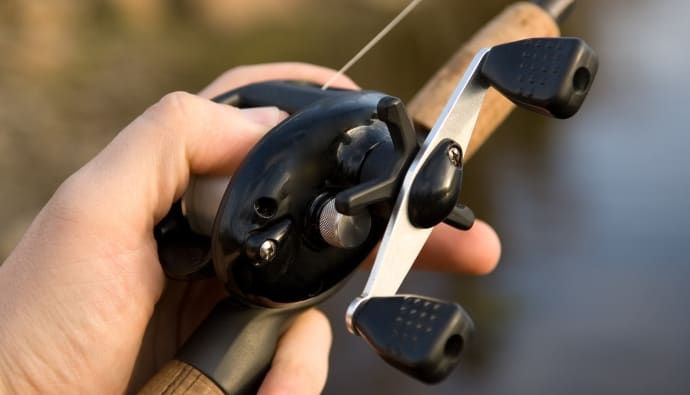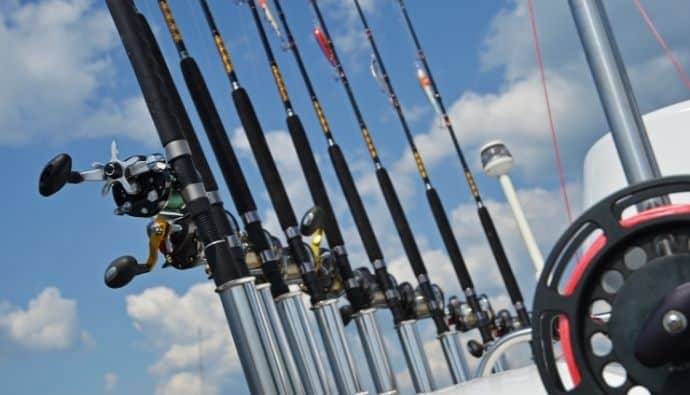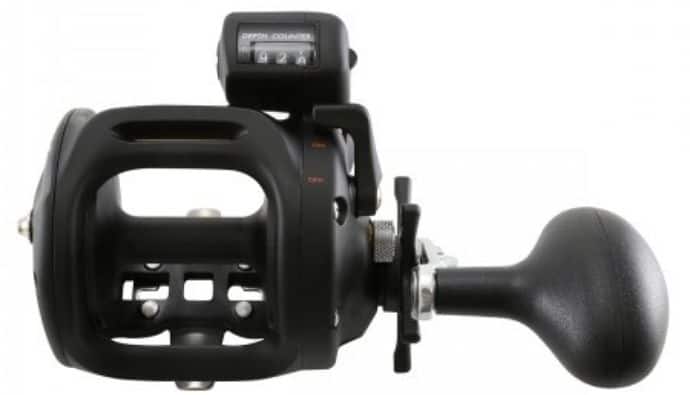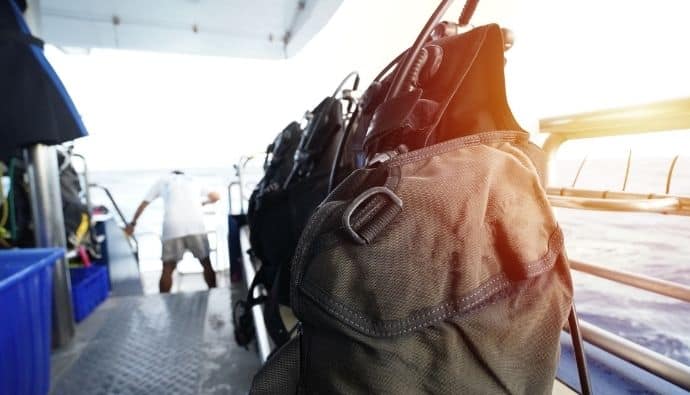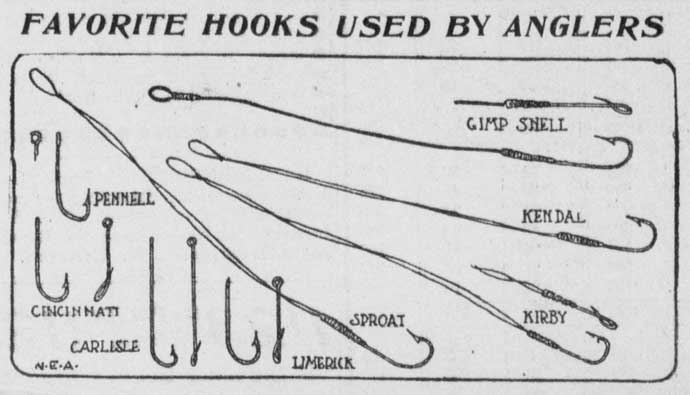A great spinning reel is one of the most important investments an angler can make. Yet, in order for it to produce the best results, it must have the best fishing line for spinning reels.
Fishing lines have been around since 1667. The best fishing lines in these times used catgut. Silk fishing lines began showing up around 1724.
Nowadays, the best fishing lines are made from monofilament, fluorocarbon, and spectra. In this guide, we’ll break down what we recommend for your spinning reel and use it on our own spinning reels.
Through the years there have been many improvements to the best fishing lines. The popular mainline types include monofilament or copolymer nylon (mono), polyethylene braided (braid), and fluorocarbon line (fluoro line).
There are also hybrid lines, fluoro-coated lines, and even Dacron and wire fishing lines, but these are less commonly used.

7 Best Fishing Lines for Spinning Reels
- Best Braided Fishing Line – Power Pro Spectra Fiber Braided Fishing Line
- Best Monofilament Fishing Line – Berkley Trilene Big Game Custom Spool
- Best Fluorocarbon Fishing Line – KastKing Fluorokote
- KastKing SuperPower Braided Fishing Line
- Piscifun Lunker Fishing Line
- P-Line CXX-Xtra Strong Fishing Line
- Seaguar Blue Label Fishing Line
1. Power Pro Spectra Fiber Braided Fishing Line
Best Braided Fishing Line
This small diameter line braid is made in the USA and is high-quality. It’s a smoother line so it is less abrasive than some of the low carrier braids, but if you’re not in thick kelp or heavy rocks, then you should be fine.
It’s a sensitive line so you’ll feel everything while you’re fishing. All the fishermen I know claim this is the best and without question, it sits at the top of the list for what you should be using on your spinning reel.
2. Berkley Trilene Big Game Custom Spool Fishing Line
Best Monofilament Fishing Line
Extreme fighting power for bigger fish can be provided by this line at a great price. Berkley Trilene’s big game line is made from super strong copolymers with incredible strength for confidence and control.
Many anglers like fishing with a spinning reel filled with Berkley Trilene Big Game, a shock-resistant monofilament line. Controlled stretch adds fighting power.
This line is also very forgiving in the knot department, with an excellent performance from a wide variety of knots. Extra tough and abrasion-resistant: this line stays tough against rough or sharp objects, making Berkley Trilene one of the best monofilament fishing lines.
Out of all the line types, it’s strong, reliable, and a great value for beginners to advanced anglers. Whether you’re fishing for large fish, small fish, saltwater, or freshwater, this line comes ready to help you land that fish!
Pros
- Very strong
- Easy to work with when spooling
- Good for a variety of fish species
- Low line memory
- Excellent strength with a variety of knots
3. KastKing Fluorokote Fishing Line
Best Fluorocarbon Fishing Line
The low stretch makes the KastKing FluoroKote a great upgrade from the monofilament line for certain applications. It’s an ideal low-cost alternative to other fluorocarbon lines.
The combination of the two materials maximizes the advantage of fluorocarbon invisibility in water.
The unique fluorocarbon materials make the line excellent sensitivity and offer great knot strength.
The diameter line of the FluoroKote is less than KastKing Copolymer Fishing lines or many monofilament line. This results in a small diameter, a strong line that gives you more reel capacity, and increased depth with diving baits.
KastKing FluoroKote Fluorocarbon sinks faster with low water absorption. The unique fluorocarbon materials make the line durable and offer good knot strength while preserving sensitivity.
KastKing FluoroKote Line is versatile, giving anglers peace of mind to fish in almost any condition and technique with confidence.
Pros
- Very low memory
- Very high density
- Great knot strength
4. KastKing SuperPower Braided Fishing Line
Incorporated strands in KastKing SuperPower Braided Line allow you to tie a more solid knot and you can even tie an improved clinch knot, though the Coach recommends using a Palomar or double Palomar knot for all terminal connections involving braid.
A special proprietary treatment (without a waxy coating) allows the supple line to fly through the guides to your target and gives you better lure swimming action.
Low memory helps you achieve better, farther casts, with less chance of wind knots and line twists.
The greater abrasion resistance of the KastKing braided lines decrease the likelihood of losing your “big one”! KastKing SuperPower Braid line’s powers are…super!
High Sensitivity
Ultra-high sensitivity and zero stretches for a superior hook setting that can increase your catch ratio.
Smaller diameter compared to other brands allowing you to spool more lines on your reel.
Whether you are fishing freshwater or saltwater, surf fishing, ice fishing, trout fishing, or bass fishing, you can count on KastKing braid to become your next small-diameter braided line.
KastKing is an ICAST Best of Show Award Winning Brand.
Pros
- Stronger breaking strength than listed in the specifications
- Extremely smooth casting with limited line twists
- Very sensitive line with great hook setting potential
5. Piscifun Lunker Fishing Line
Piscifun Lunker is our budget line recommendation.
Thanks to its zero stretch, Lunker braid transmits information from your lure better than any other type of line.
Lunker braid slices through vegetation like a knife when fighting fish.
Pros
- It does not lose dye like other braided lines.
- Rarely any inconsistencies in the line and limited line twist.
- Very easy to tie, and holds knots well.
6. P-Line CXX-Xtra Strong Fishing Line
CXX X-Tra Strong is the strongest line as well as the toughest, most shock-resistant monofilament line on the market.
If you’re looking to throw into a nasty cover for largemouth, battle huge tuna with your drag locked down to some ridiculous setting, or pull plugs for monster salmon in a raging river, there is only one line to trust. This might be one of the best line for spinning reels ever made…
Tournament anglers and guides alike choose CXX because of the abrasion resistance and its high strength-to-diameter ratio. And with 5 colors to choose from, you’re certain to have the perfect shade for any condition, with minimal line fading.
More anglers prefer fishing with spinning reels with a clear line than any other color, which made CXX X-Tra Strong in the Crystal Clear color a natural choice. Perfect for any water condition and if casting distance matters to you.
Pros
- Breaks at a much higher tensile strength than advertised.
- The line is made to cast smoothly and further than others of equal test with limited line twist.
- Clear color allows the line to be less visible to fish in the water.
7. Seaguar Blue Label Fishing Line
Seaguar doesn’t feel as popular as some of the newer brands out there, but its products have stood the test of time. This Blue Label fishing line is no different. Some might even consider Seaguar to be the best fluoro line on the market.
If you’re looking for a fluorocarbon fishing line that has reduced visibility and top-grade tensile strength then you need to give this line a shot.
Our recommended knot is the John Collins knot for securing this leader line to braid.
What is a Spinning Reel?
Before we get started talking about what goes into picking the best fishing line, let’s first talk about what is a spinning reel.
There are several different spinning reel sizes to accommodate the type of fishing you want to do.
Spinning reels have a fixed, open-faced spool positioned in line with the surf fishing rod. The spool is stationary and a rotor/line guide revolves or spins around the fixed spool.
This type of reel mounts below the rod, held in the right hand. The reel’s crank turns with the left hand, although most models come with the ability to reverse the handle if you are more comfortable.
Wide Variety
Spinning reels can handle line weights as low as a one-pound test, and can cast very light lures when matched with the proper rod. Larger models are for bigger fresh and saltwater species and can handle thicker lines, heavier lures, and beefy applications like big sharks, Amazon catfish, or even tuna.
All spools have a line capacity, which will help you decide on which reel to select. This information is on the spool. Often, the right fishing line to use on the reel is in the mid-range listed on the spool.
Why would you use spinning reels instead of conventional reels?
Spinning reels have fixed spools while conventional reels have spools that release or spin when casting (these are often called multiplier reels in some parts of the world).
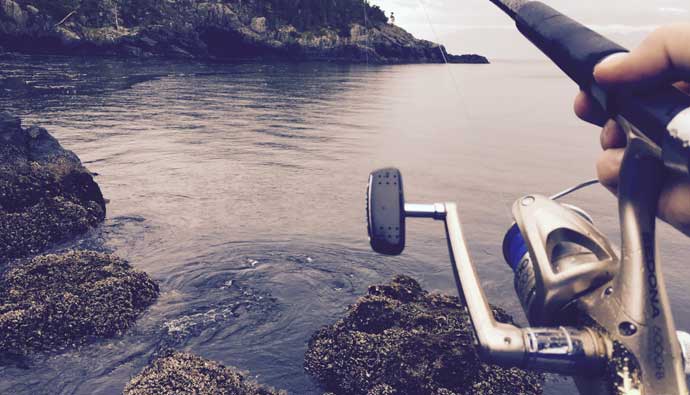
Spinning reels are user-friendly, especially for beginners and children learning to cast, but still widely used even by advanced anglers.
Spinning reels do not tend to backlash or tangle easily, and some anglers prefer the way they cast over conventional reels. Conventional reels will cast farther with proper technique and experience, but spinning reels will cast a decent distance much easier with less effort.
How To Put Line On A Spinning Reel
Things to Consider When Picking the Best Fishing Line (Buying Guide)
It’s important to pick the right fishing lines when you’re just getting started with fishing. All too often, new anglers want to jump in with what others are using around them.
Most of the time this means braided fishing lines. Braid is great for certain applications, however, it can be a steep learning curve. Instead, how about focusing on using the easiest line to learn catching a few fish, before focusing on specific techniques?
In this video, Coach goes over a few things a new fisherman/woman should consider when picking their fishing line.

Types of Fishing Line For Spinning Reels
Braided Fishing Line
The braided line was one of the earliest types of commercially produced fishing lines. It’s popular because of its high knot strength, lack of stretch, and great power in relation to its diameter. Best of all it’s a super-sensitive line!
Braids are from natural fibers such as cotton and linen. were common early braided fishing lines. Natural fiber braids have changed to man-made materials like Dacron, high-density polyethylene, Spectra, and Dyneema.
The quality of a fishing line will determine how well it stands up to abrasion since sharp or abrasive objects can cut and damage braided line. Their actual breaking strength may well exceed the pound-test rating.
These lines usually have 1/3 to 1/4 the diameter of the monofilament line or fluorocarbon lines at a given diameter.
It is easy to fit a more braided line on a spool than a monofilament line or fluorocarbon line for the same strength. This is very important for deep-sea fishing since reels don’t have to have a large capacity to accommodate long lines.
Also, thin braided lines provide less resistance to sea currents, while cutting through obstacles like kelp, sargassum, or eelgrass.
These lines have a very little stretch. This makes fishing rigs very sensitive to fish bites. This is important for both deep-sea fishing and when targeting fish with a gentle bite.
Due to the minimal stretch of the braided line, hard-hitting fish will often cause the fishing line to break. Thus it is very important to set the drag on reels at very low values when fishing large fish on modern braided lines.
Braided fishing lines are very flexible and can be easier to cast over long distances. Braided fishing lines float, and as such, are a common choice for topwater rigs, etc.
One drawback of braided lines is that they are visible in the water, and therefore visible to fish. Many anglers attach a monofilament line or fluorocarbon line to the end of their braid fishing line to serve as a leader and to reduce the braid’s visibility.
Due to their flexibility, lack of stretch, and most important, slippery surfaces, braided lines are hard to knot. There are several knots that work with braided lines: Palomar knot, Berkley braid knot, San Diego jam knot, Trilene knot, Albright knot, etc.
These lines, particularly the newer synthetics, work on most types of fishing reels. They make excellent lines for baitcasting reels for surface work and for dropping baits deep into the ocean.
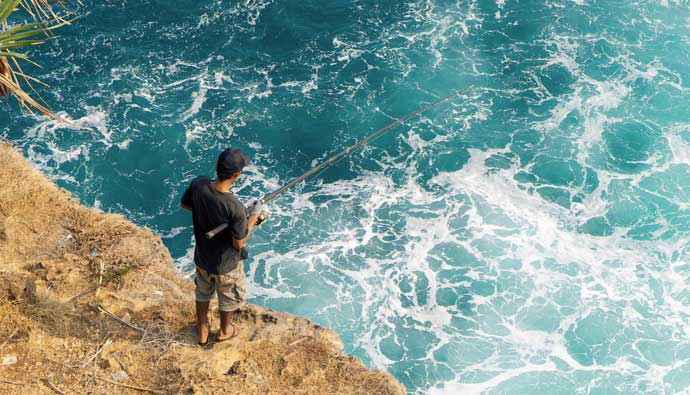
Mono Fishing Line
As its name implies, monofilament “mono” is a single strand of material. Unlike multi-filament lines, which are strung from fused, twisted, braided, or bundled together strands.
Monofilament comes from different materials, the most common being nylon. Blending different varieties of nylon together into co- and multi-polymers produces different characteristics.
This includes levels of stretch, strength, and abrasion resistance.
Here are some benefits of monofilament fishing lines.
Easy to handle
Thanks to its flexible nature, monofilament is easy to use and works well for many fishing situations. This flexibility often described as limpness makes mono more manageable and easier to cast than stiffer lines.
Stretch
Mono stretches more than superlines and fluorocarbon lines, which gives it a forgiveness factor other lines can’t match. If your drag sticks or you set the hook too hard, mono compensates by stretching up to 25 percent or more.
By stretching under pressure, mono also helps prevent your hook from tearing a hole in a fish’s mouth. This stretch makes it easier for the angler to land a fish with less skill in drag adjustment.
This is a factor both on the hookset and during the fight, especially when you’re dealing with big fish in close quarters. For example, many top bass pros prefer a beefy mono like Berkley Big Game over superline for pitching jigs.
Shock strength
Stretch should not be confused with shock strength, which is a fishing line’s ability to absorb energy. Shock strength comes into play when your fishing line has to withstand the sudden impact of a hard hookset or a big fish thrashing at the boat side.
Sink rate
Thanks to its near-neutral buoyancy, mono sinks, make it a great choice for topwater lures. This suspends subsurface presentations where you don’t want to hasten the bait’s downward movement.
Color palette
Mono is easier for manufacturers to tint than other types of lines, so it’s available in a vast range of colors. You can choose from stealthy, low-visibility options such as green, blue or clear. Spin the color wheel in the opposite direction and spool with high-vis shades like chartreuse, blaze orange, or neon blue. These ‘high viz’ lines are perfect for line-watching presentations (or even fishing at night with black light as illumination for fighting huge fish in the dark).
Some monos, like Berkley Trilene TransOptic, offer the best of both worlds by changing color from bright gold in sunlight to low-vis clear below the surface.
Ease of use
Thanks to a combination of manageability, stretch, easy knot tying, and other features, mono is the best ease-of-use fishing line. A great choice for first-time anglers for general use or seasoned veterans needing specific techniques.
Fluorocarbon Fishing Line
In the fishing world, it’s associated with polyvinylidene fluoride (PVDF). It’s extruded in a single strand similar to nylon monofilament. But because fluorocarbon molecules are more tightly packed, the fishing line is denser and noticeably heavier by size. It also differs in invisibility, stretch, and durability, all of which affect how it performs in the water.
Low visibility, one of the fluorocarbon line’s biggest benefits is that it’s nearly invisible underwater. This is because it does not distort light passing through the line (it has the same refractive index as water), and it’s a huge factor in clear water and when targeting skittish fish.
Sensitivity
Fluorocarbons packed molecules transfer more energy than mono. This results in a better feel from the other end of the line, such as light bites or your lure ticking bottom. Also boosting sensitivity, fluorocarbon sinks faster than mono, resulting in less slack or bows between the lure and rod tip.
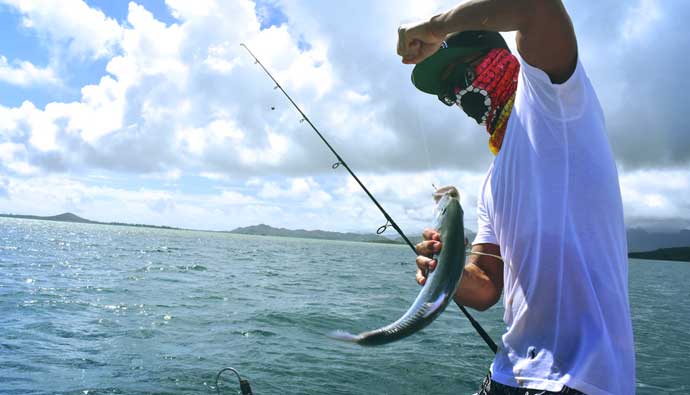
UV Toughness
Fluorocarbon is more UV or sun resistant than standard nylon monofilament of the same diameter. While the sun’s harsh ultraviolet rays weaken nylon over time, fluorocarbon shrugs off UV with no ill effects.
Waterproof
Unlike mono and some superlines, fluorocarbon does not absorb water. This means it has the same strength, sensitivity, and handling below the surface as it does when dry. It feels and acts the same on your first cast as it does on your last.
Hooking power
Lacking the low-end stretch of nylon mono, fluorocarbon delivers more solid hooksets, even at long distances. If you need to drive the hook home at the end of a long cast, this is a key consideration.
Diameter
Fluorocarbon is about the same diameter as nylon monofilament of the same break strength. Because fluorocarbon is hard for fish to see, you can upsize the pound test for extra strength and abrasion resistance, without spooking line shy fish.
How to Spool a Spinning Reel
When spooling a spinning reel, note which way your reel bail turns. Hold your empty reel the way it would be oriented on your fishing rod and turn the handle as you would when retrieving.
Note the way the bail turns. This is the way the line will be spooled onto the reel; the opposite direction is the way the line will peel off the spool when you cast.
Spinning reels are designed to hang down from the rod, not rest above it like spin casting and baitcasting reels.
Hold the reel when it’s not mounted on the rod, wrap the fingers of your casting hand around the mounting bar and let the reel hang from that hand while reeling with your other hand.
Note which way the line is wound on the filler spool. You want to orient the filler spool so that the line peels off it in the same direction.
Your reel bail turns when you turn the reel handle, in other words, it comes off the filler spool in the same direction in which it winds onto the reel.
Tie the end of the line to your spool. Use either an arbor knot or a uni-knot. The Coach uses various hitch and loop knots if time is at a premium and the knot is not expected to see actual use.
When possible, mount your reel on the rod and thread the line through the guides before attaching it to the reel.
Where to Begin
Begin reeling the line onto your spool. Turn the crank handle slowly with your cranking hand.
You can add tension by passing the line between the fingers of your casting hand, by raising the rod slightly if your reel is on the rod, or by running the line through a thick book at the spine. Combine methods if more tension is needed.
If you’re filling the reel by yourself, place the filler spool flat on the floor and let the line spool off it onto the reel and introduce some slack to see if it doesn’t tangle immediately.
Coach tosses the spool into a warm (ish?) bucket of soapy water and lets the spool do its thing while he winds the line through his fingers. This allows the spool to turn around or over if it begins developing kinks or twists.
If you have an assistant, have the assistant thread a pencil or dowel through the filler spool, holding it parallel to the direction of the spool. The assistant can apply finger pressure to the spool to supply tension to the line.
Check the line for a twist after cranking a few times. If you’re taking up the line on the spool the same way it pays off the filler spool, you should not have a twist.
Read Also: Best Fishing Line Spoolers
Check for Twist
You should still let the line go slack to check for a twist. If there is a twist, the line will start twisting away from the spool. You then have to peel off the line, flip the filler spool over, and start again.
Continue filling the spool to within 1/8 inch (3.2 mm) of its rim.
Your reel may have a tab or mark on its spool that lets you know when you’ve filled it to the proper amount.
If you underfill the reel, your casts will be shorter because of the friction of the line rubbing against the top flange of the spool.
If you overfill the reel, the line may absorb enough water when it gets wet to slip past the flange and cause a ‘wind knot’ when you cast.
Cut the line off the filler spool when finished. You may want to put a rubber band around the spool to keep the line in place if you’re not going to fish with the reel right away or use the reel’s own line holder if it has one.

Read Also: Best Ultralight Spinning Reels
How to Put Line Through the Rod
- Release the winding mechanism of the reel so that the line can unspool.
The method of releasing the line varies depending on whether you’re using a spinning, baitcasting, or spin cast reel. For a spinning reel, open the bail wire so the line can unspool. Baitcast and spin cast reels depress and release with the large button on the back of the reel.
- Feed the “tag” or free end of the line through the first “eye” or line guide.
You may need to apply a small amount of pressure on the spool of the reel to prevent the line from overrunning and becoming tangled.
- Pass the line through each of the eyes.
As you do, always hold it with one hand to prevent the line from sliding back through the eye.
- Pull the line through the guide at the tip of the rod, leaving 3 to 4 feet of the line extending from the end of the rod.
This gives you enough line to work with when you tie on lures and hooks.
- Engage the winding mechanism to prevent the line from unspooling.
This involves turning the handle of the reel forward, which engages the mechanism. It is important to note, with braid, it may be very important to move the bail to the closed position by hand to prevent line twists and ‘wind knots’.
Casting a Spinning Reel
Grip the rod with your casting hand around the reel seat. Put your index and middle finger ahead of the reel and your other 2 fingers behind it.
Unlike spin casting or baitcasting reels, spinning reels reel with the hand opposite the one used to cast with. As most fishermen cast right-handed, most spinning reels have the handle on the left.
Spinning rods are also longer on average than spin casting rods. Without a recessed seat and with the guide nearest the reel seat is somewhat larger than the other rod guides to permit the line to flow more when you cast.
Reel in until your bait is 6 to 12 inches (15 to 30 centimeters) from the rod tip. If you have a sinker or bobber attached to the line, it should be 6 to 12 inches from the rod tip instead.
Your Index Finger
Crook your index finger to pick up the line ahead of the reel and press it against the rod.
Open the reel bail. The bail is a loop of wire on the rotating rim outside and behind the reel spool. It gathers the line when you reel it in and deposits it on the spool.
Opening it moves it out of the way of the line so you can cast your lure.
Swing the rod back past your shoulder. Sweep the rod forward, releasing the line as you extend your arm. To help you target your bait to the casting distance area, point your index finger at the place you want to release the line. You may find this technique difficult at first.
If you are casting with a long-handled spinning rod of the kind used in saltwater fishing, you’ll want to use your reeling hand as a fulcrum from which to pivot the rod as you cast.
Frequently Asked Questions
KastKing Superpower braided fishing line is our value pick with its small diameter and overall strength for the cost.
KastKing FluoroKote Fishing Line
A spinning reel is a fixed spool device attached to a fishing rod used in winding and stowing line. Modern fishing reels usually have fittings aiding in casting distance and accuracy, as well as retrieving lines.
10-20 pound test. When it comes to bass, even a two-pound bass can exert up to eight pounds of pressure on your line.
Braid works best when dealing with lots of weeds, twigs, or grass, especially in topwater presentations.
A 10-15-pound test line is a good choice if you are not sure what you will be fishing for.
If you are going to be fishing in cover, say for bass braid is the best fishing line for bass. This is because they are usually found in deep cover where fish can affect the strength of your line by running into deep weeds, etc. Mono is a good choice for most other species where the heavy cover is not an issue.
P-Line CXX-Xtra Strong Fishing Line
A spinning reel is a good starter reel for a less experienced angler because they are very user-friendly. Small creeks and ponds are other places to use spinning reels, though some advanced anglers use them for saltwater jig work, topwater poppers for tuna, or even Giant Trevally.
This can be due to the line being spooled too loose on the reel, it can also be due to allowing too much line to feed out on the cast. It can also be due to overfilling the spool, or the line not wound on the reel under the proper tension.
Insider Advice
There are many different types of fishing lines available, in this article, we have covered the best fishing line for spinning reels.
Out of the brands we have covered, we feel the P-Line CXX-Xtra Strong or the KastKing Superpower is the best fishing line for these types of reels. You’ll get solid hook sets with either of these lines.
The p-line is strong and works well with most lures, and is durable.
It is a good idea to keep a check on your fishing line, and look for signs of wear and abrasion. When in doubt, go ahead and add a new line.
Remember, if you’re a beginner, use a monofilament line until you’re comfortable switching to braid or fluoro if the situation calls.





 Facebook
Facebook YouTube
YouTube